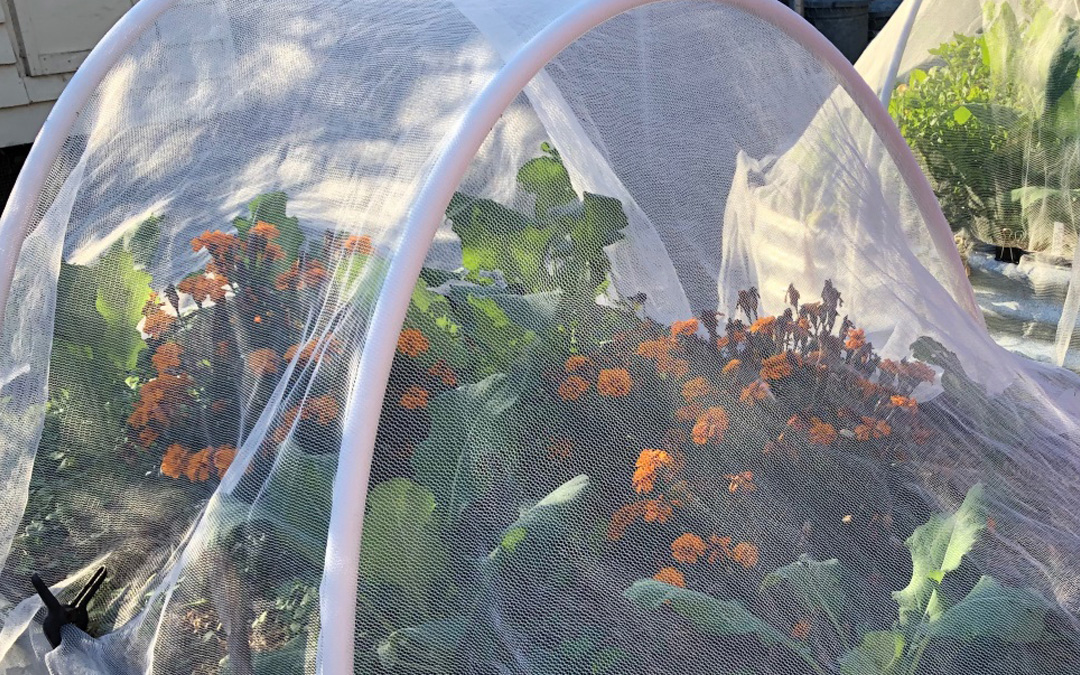Net for success!

We are repeating this article written in November 2021 because, now more than ever before, it is urgent to net to protect fruit and vegetables from Queensland Fruit Fly. Without the right kind of net, properly secured at ground level, you can expect your harvest to be ruined by this pest. Lures are useful but not enough.
QFF seems to have arrived late this year, most likely because the winter was long and cold, but they are here. At the community garden we have caught 10 in traps in the last 10 days. Anywhere that there is ripe fruit (sometimes the left-overs from the winter which haven’t been stripped from the trees), infestation will have begun. You will see small maggot-like insects when you open the fruit and these will jump if they fall onto your bench – only QFF jump!
Citrus trees at the community garden are flush with small unripe fruit so we hope we have netted in time. There was no QFF in the stone fruit orchard this season which means that our netting there was 100% successful. In particular you should net tomatoes, capsicums, chillies and eggplants. Netting eggplant also keeps out eggplant caterpillars which leave a black poo trail through the white flesh.
We still have some net bags which are free to anyone in the community, and available on Wednesday and Saturday afternoons, at the Sustainable Macleod Community Garden on Somers Avenue about 150 metres past the NETS Stadium. These are courtesy of a grant from Banyule City Council.
Read the following article to determine the right sort of net and where to source it. At $4.95 a metre, it is not expensive to protect your hard work!
Netting selection is a vital aspect of insect control in the fruit and vegie garden. Appropriate mesh size will protect fruit and vegetables from a range of insects while inappropriate may increase the numbers of non beneficial insects including aphids and thrips.
Let’s begin with net that encourages non beneficial insects. Very fine net – certainly net with mesh less than 1 x 3mm or 2 x 2mm – does not allow sufficient ventilation inside the netting, and creates a warm microclimate that is conducive to heavy breeding of certain bugs especially thrips and aphids. What’s more, the mesh is too fine for these to exit and escape. If you wanted to breed these bugs, you would have created the perfect environment to do so! Be choosy about the material the net is made from, with some synthetics heating up considerably more than cotton or cotton based netting.
The very best way of controlling non beneficial insects is to create an environment that supports beneficial insects which will eat the non beneficials at the soft body stage. Plant with as much biodiversity as possible. White and yellow flowering plants are particularly attractive to beneficial insects.
However, if this is not enough, netting after pollination is the next best bet. Clearly, timing is of the essence. Netting too early will exclude the pollinators that transfer pollen from flower to flower and result in no fruit set. Netting too late, while better than nothing, is likely to have resulted in some damage to foliage, for example from sucking insects, which weakens the plant.
Netting needs to be comprehensive. Any holes need to be sewn up and the edges need to be weighed down with weights or soil. Net over trees should either be weighted around the base or tied firmly to the trunk.
For all fruit and vegies white netting with mesh 1 x 3mm or 2 x 2mm should be used. I prefer the latter which I am able to buy off the roll at Bulleen Art and Garden. Buying off the roll allows me to determine the lengths I need and it is much wider than that purchased in packets. Net that is narrow is rarely useful except perhaps for a low cloche as it does not have sufficient margins to hang down the sides or if necessary for the edges to be weighted or covered. White net helps prevent sunburn on produce.
Netting is particularly valuable for brassica family plants including cauliflower, cabbage, Brussel sprouts and broccoli to deter white cabbage moth, solanaceae family including tomato, eggplant, capsicum and chilli to deter other caterpillars, and any vegetable or fruit prone to being eaten by rodents and possums. Be aware that rats can tear holes in net if hungry enough. Rats can also climb up netting so in the case of wooden wicking beds, make sure net is not left to drag on the ground and secured instead at the top edge of the bed. Corrugated beds are too slippery for rats to climb but likewise, keep the net as high off the ground as possible.
Netting is the most successful preventative for Queensland Fruit Fly in both fruit and vegetables and for this reason is an essential tool in the garden. It also prevents bird strike.
Written by Robin Gale-Baker
